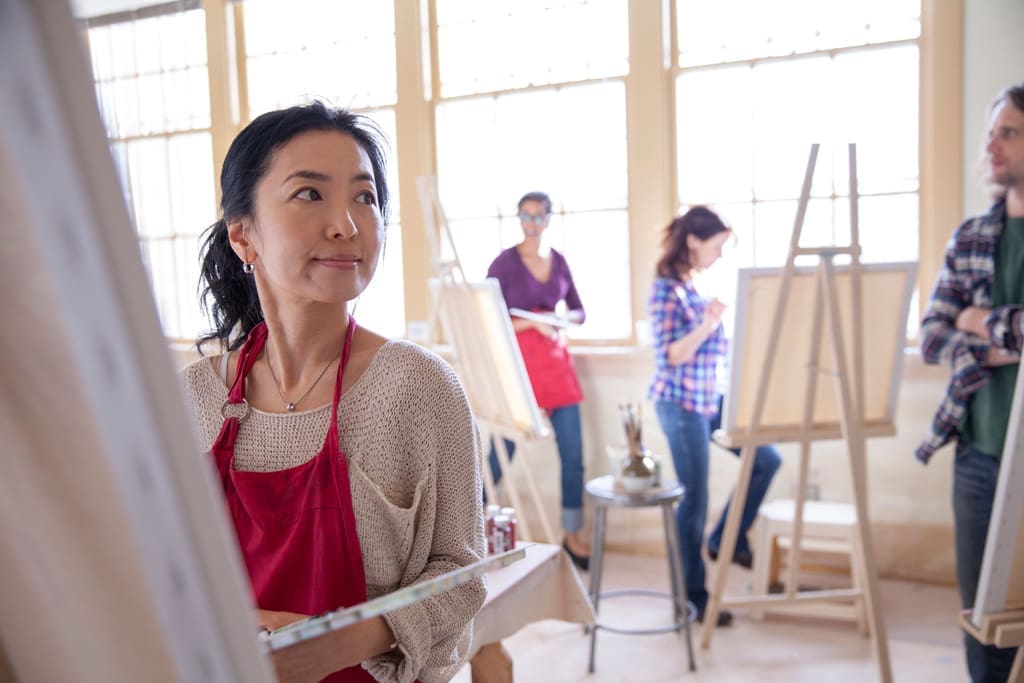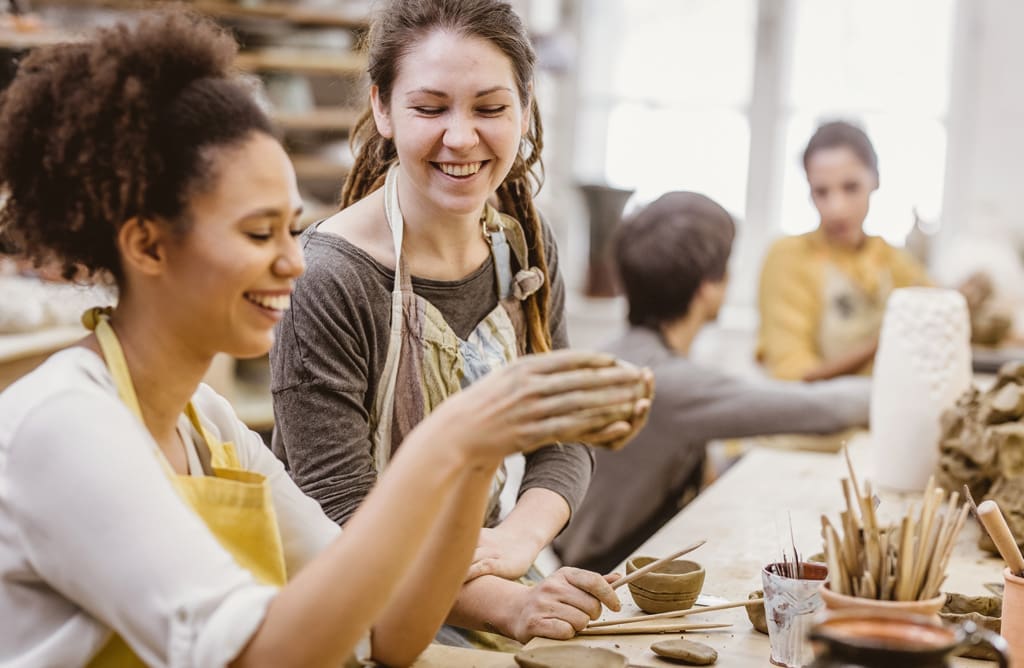What is Anxiety?
Anxiety is a common and natural human emotion characterized by feelings of fear, worry, or unease. It is often accompanied by physical sensations such as increased heart rate, rapid breathing, sweating, and restlessness.
While anxiety can be a normal response to stressful or uncertain situations, it becomes a concern when it becomes excessive, persistent, and interferes with daily life. Art therapy for anxiety management is just one of many holistic treatment measures to manage symptoms.

Anxiety Disorders
Anxiety disorders are a group of mental health conditions where anxiety becomes chronic, excessive, and difficult to control. Some common anxiety disorders include generalized anxiety disorder (GAD), panic disorder, social anxiety disorder, and specific phobias.
These disorders can cause significant distress and impair a person’s ability to function in various areas of life. If you or a loved one are experiencing negative symptoms stemming from anxiety, it is important to seek treatment – such as pursuing art therapy for anxiety.
Symptoms of Anxiety
Symptoms of anxiety can vary from person to person but may include excessive worrying, restlessness, irritability, difficulty concentrating, muscle tension, sleep disturbances, and avoidance of anxiety-provoking situations.
Risk Factors for Developing Anxiety
Anxiety disorders can be caused by a combination of factors, including genetics, brain chemistry, personality traits, and life experiences such as trauma or significant stress.
How Does Art Therapy for Anxiety Work?
Art therapy for anxiety works by providing a safe and non-judgmental space for individuals. It enables these individuals to express their emotions through the creation of art.
Art therapy for anxiety aims to bring about healing through the creative process.
Benefits of Art Therapy for Anxiety
Art therapy for anxiety is a powerful and effective way to manage stress, worry, and fear symptoms. It’s an expressive form of therapy that helps individuals learn how to regulate their emotions.
During art therapy sessions, clients explore different techniques for managing their anxiety.
The Process of Art Therapy for Anxiety
The process allows individuals to explore and communicate their feelings in a creative and non-verbal way. It is helpful for individuals with difficulty expressing their emotions. It also helps them address their anxiety more healthily.
Art therapy aims to help clients better understand and manage their anxiety symptoms. It also provides a safe, supportive environment for exploration and expression.
How Art Therapy for Anxiety Works Physically and Mentally
During art therapy sessions, clients explore different techniques for managing their anxiety. Some of the ways art therapy helps with anxiety will be detailed below.
Calming the Nervous System
Art therapy can help calm the nervous system by engaging the creative and expressive parts of the brain. These brain parts can shift the focus away from anxious thoughts and promote relaxation.
Art therapy can help reduce these physical symptoms by promoting relaxation and calming the nervous system. It helps to manage the nervous system by allowing individuals to express themselves in a nonverbal medium.
Increasing Self-Awareness
The act of creating art is a powerful tool for self-reflection and self-discovery. As individuals work on their art projects, they may gain new perspectives on their thoughts.
These individuals will recognize patterns or themes in their artwork that contribute to their anxiety, which helps to increase self-awareness by providing a supportive environment.
Verbal Expressions
For individuals who have difficulty verbalizing their feelings, art therapy can provide a safe and non-judgmental space for expressing emotions through creative means.
This can be especially helpful for individuals who struggle with anxiety, as it can be difficult to put anxious thoughts and feelings into words.
Providing Tactile Stimulation
The tactile nature of art therapy is helpful for individuals who have difficulty expressing themselves verbally. It can promote relaxation and mindfulness.
Individuals who work with art materials may notice the materials’ texture, weight, and temperature, which helps to promote a sense of presence and mindfulness in the moment.
How Creating Art Therapy for Anxiety Helps Individuals Manage Symptoms
Creating art is a powerful tool for managing anxiety. The process of creating art can help to relieve stress and reduce symptoms associated with anxiety.
Some of the ways art helps individuals with anxiety manage symptoms are:
- Artmaking promotes relaxation and mindfulness: The process of creating art can be calming and meditative, which can help reduce feelings of anxiety and promote relaxation. As individuals focus on the creative process, they may become more mindful of their thoughts and feelings, which can help them gain perspective and reduce anxiety symptoms.
- Artmaking provides a sense of control and empowerment: Creating art can provide a sense of control and empowerment. It enables the individuals to actively participate in the creative process and make choices about the materials and techniques they use. This can be especially helpful for individuals who feel overwhelmed or powerless due to anxiety symptoms.
- Artmaking provides a way to process and work through difficult emotions: By creating art that represents their emotions and experiences, individuals can gain a deeper understanding of their thoughts and feelings and may be better equipped to process and work through difficult emotions related to anxiety.
What Types of Activities Are Commonly Used in Art Therapy for Anxiety?
Art therapy for anxiety often incorporates a variety of art activities. According to the British Association of Art Therapists in 2015, the goal of art therapy is to enable clients to grow on a personal level through artistic materials in a structured environment.
The art therapist may choose to use a combination of different activities depending on what will be most helpful for the individual.
Art Therapy for Anxiety Activities
Some commonly used art activities in art therapy for anxiety include:
- Drawing and sketching: Drawing and sketching can be a simple and accessible way to express emotions and explore ideas. This activity is helpful for individuals who are new to art therapy.
- Painting: Painting can be a versatile and expressive medium to create abstract images. Watercolors, acrylics, and oils are commonly used. According to a study conducted on 80 individuals divided into two groups, the group that practiced self-awareness training with painting showed an increased self-awareness skill.
- Sculpture: Sculpture involves creating three-dimensional objects using clay, wire, or found objects. This activity is best for individuals who benefit from tactile stimulation or have past trauma.
- Mixed media: Mixed media involves using various art materials and techniques in a single piece of artwork. This activity is best for individuals who enjoy experimenting with different materials and methods.
- Music Therapy: This involves using music to express feelings, explore personal identity, and promote relaxation. It also helps to focus on specific anxiety-related issues, such as negative thinking patterns and social anxiety.
Can Art Therapy for Anxiety Be Independently Effective?
Art therapy for anxiety can be effective on its own for some individuals. The effectiveness may vary depending on the individual and the severity of their anxiety symptoms.
Art therapy can provide a unique and creative approach to managing anxiety. It is helpful for individuals who have difficulty expressing their emotions verbally.
However, it’s important to note that art therapy may not be effective as a standalone treatment for all individuals with anxiety since some may benefit from additional treatments, such as cognitive-behavioral and art therapy.
The Creative Process of Making Art
The creative process of making art can provide a sense of control, empowerment, and relaxation. It can help reduce anxiety symptoms. Art therapy can help individuals gain insight into their thoughts and feelings. It can help manage anxiety.
It’s also important for individuals with anxiety to work with a qualified and licensed art therapist. The therapist should be able to provide appropriate guidance and support. This therapist will help the individual develop coping skills and help tailor the art therapy sessions to meet their specific needs.
Benefits of Using Art Therapy for Anxiety Compared to Talk Therapy
Traditional talk therapy is great for individuals needing to express their feelings through words, while art therapy is better for some who struggle to verbalize and use creative means instead.
Some of the benefits of using art therapy for anxiety compared to traditional talk therapy are:
- A deeper understanding of emotions: Art therapy helps people to become more aware of their emotional state. This deeper understanding can help them develop better coping mechanisms for anxiety management.
- Improved communication: Art therapy for anxiety encourages individuals to express themselves creatively. It helps to enhance communication between the patient and therapist and, therefore, can express their feelings more accurately than with verbal communication.
- Creative problem-solving: Art therapy encourages creative problem-solving. It enables individuals to explore different possibilities for managing their anxiety. This exploration can lead to new ways of thinking.
- Increased confidence: As individuals become more aware of their emotions, their self-confidence can improve. This increased sense of security helps them feel less anxious and enables them to equip themselves and handle stressful situations better.
- Increased sense of connection: Through art therapy, individuals can feel more connected to themselves and others. This improved connection helps people develop healthier relationships leading to reduced anxiety levels.
- Increased sense of hope: Art therapy provides a safe environment for expression, leading to hopefulness about the future. With improved self-understanding, individuals can have greater confidence in coping with stress-inducing situations.

Finding a Qualified Art Therapist to Work With for Anxiety
Before beginning your art therapy journey, finding a qualified art therapist to work with for anxiety is vital. Check your health insurance coverage to know if art therapy is a covered benefit. If so, the insurance company may have a list of in-network art therapists you can choose from.
You can also research mental health facilities that offer art therapy, such as True Life Care. These facilities often have qualified art therapists, which can make your recovery journey smooth. Before committing to work with an art therapist, you can schedule a consultation.
The consultation is vital to discuss your goal and needs for the therapy. It is also an opportunity to ask about their experience working with anxiety. This helps to ensure you feel comfortable and confident in their approach.
Treat Your Anxiety at True Life Care
At True Life Care, we have professional healthcare providers that will guide you toward recovery. We offer a range of treatment options, such as art therapy, to aid healing. True Life Care ensures your comfort in a safe and structured environment.
Reach Out and Begin Healing
At True Life Care, you can discuss your needs with the knowledgeable staff that provides your comfort during therapy. Our therapists will guide you through sessions based on your individualized goals and needs.
You can reach out to us today to begin the journey towards regaining wellness and autonomy over anxiety. To learn more about Art Therapy for Anxiety in New Jersey, contact our admission office for more informations.
Resources
- https://commons.emich.edu/cgi/viewcontent.cgi?article=1162&context=mcnair
- https://www.frontiersin.org/articles/10.3389/fpsyg.2021.686005/full#B14
- https://pdfs.semanticscholar.org/6db7/7a3b9f20b7df92c891b1fa480481e0b6cb95.pdf
- https://www.nm.org/healthbeat/healthy-tips/emotional-health/communicating-through-art















